Plastic producten zijn overal. Vooral badkamers raken snel overvol van plastic als we er niet op letten. Kijk bij je volgende badkamerbezoek maar eens goed om je heen. Staat die van jou nog vol met flessen shampoo, douchegel en conditioner? Of tandenborstels, wattenstaafjes en andere plastic producten? Hoogste tijd voor een duurzame make-over. Veel traditionele verzorgingsproducten bevatten immers foute ingrediënten die schadelijk voor je lichaam kunnen zijn. Daarnaast zijn plastic producten vaak slecht te recyclen en blijven ze om die reden levenslang liggen op vuilstortplaatsen of nog erger, in de natuur.
Zorg goed voor jezelf en onze toekomst. Stap daarom over op duurzame alternatieven. In deze blog geven we je 7 tips voor een plasticvrije badkamer die jou gaan helpen met een gezonde en duurzame persoonlijke verzorging.
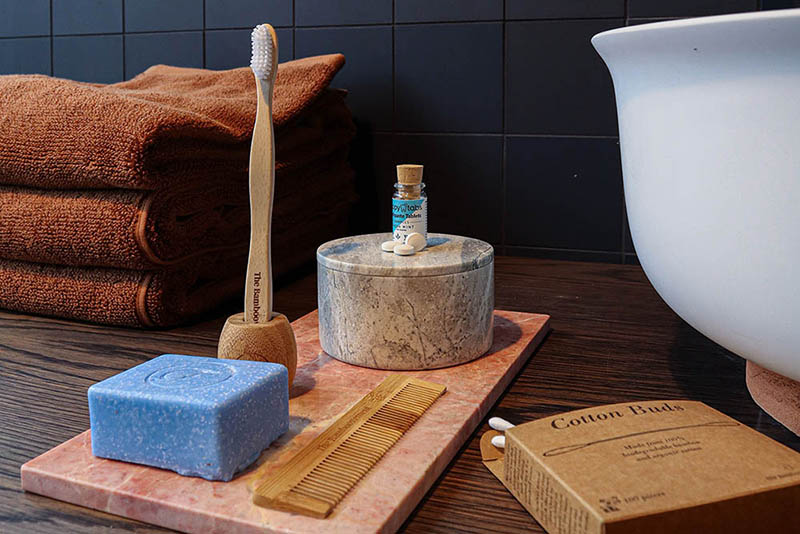
Om maar meteen met de deur in huis te vallen: vaker dan je lief is zitten er schadelijke stoffen in de meest gangbare shampoo, douchegel of conditioner. Misschien heb je wel eens gehoord van parabenen en siliconen en probeer je die te vermijden. Dat is een mooi begin maar de lijst van te vermijden schadelijke stoffen is lang. Wist je bovendien al dat de plastic flessen waar dit soort vloeibare goedjes in zitten vaak niet gerecycled worden? Nog een goede reden om direct over te stappen op iets dat beter is voor jou én de aarde. Ons advies? Ruim de flessen en maak plaats voor bars!
De keuze is echter reuze. Er zijn tegenwoordig talloze opties met elk een eigen verhaal. Uiteindelijk hebben we bij The Bamboovement gekozen voor de bars van HappySoaps. Deze zijn 100% vegan, palmolievrij en ze worden in Nederland geproduceerd: allemaal eigenschappen waar wij veel waarde aan hechten. Daarnaast schuimen ze heerlijk. Daar is het schadelijke stofje SLS blijkbaar helemaal niet voor nodig. Zijn er nog meer voordelen te noemen? Ook niet verkeerd is dat één bar gelijk staat aan 3 tot 4 flessen - tel uit je (milieu)winst!
Voorheen stond hier natuurlijk de tip om over te stappen van de plastic variant op het bamboe alternatief, maar met dank aan de nieuwe wetgeving van de EU is die inmiddels achterhaald. Sinds juli 2021 geldt er immers een Europees verbod op plastic wattenstaafjes. Reden voor een feestje!
Mogelijk heb je nog ergens een open doosje of een voorraad ouderwetse wattenstaafjes liggen en kan je nog even vooruit. Feit is echter dat je toekomstige wattenstaafjes sowieso plasticvrij zullen zijn - o, wat fijn. Om dat met je te vieren, krijg je bij aanschaf van bamboe wattenstaafjes een extra pakkie gratis en voor niets. De actie is onbeperkt geldig op maximaal 3 doosjes per bestelling. Sla snel je slag en gebruik deze couponcode: WATTENBAASJES.
Wist je dat een tandenborstel maar 12 weken meegaat? De haartjes poetsen daarna niet meer optimaal. Dit is de reden waarom tandartsen en mondhygiënisten aangeven dat dat hét moment is om over te stappen op een nieuwe. Op jaarbasis zijn dit 4 tandenborstels per persoon.
Poets jij al je hele leven met plastic handtandenborstels? Ga dan maar eens na hoe hoog de berg tandenborstelafval is als gevolg daarvan. Of die ooit nog zal slinken? Alleen door de tandenborstels in de fik te steken, dat is immers wat er gebeurt met niet of slecht recyclebaar plastic afval. De onverbrande hoop blijft honderden jaren liggen omdat het niet biologisch afbreekbaar is. In de tussentijd breekt het af tot enorm schadelijke microplastics.
Onze tip? Stap elke 12 weken over op een bamboe tandenborstel en zorg zo goed voor je gebit én voor het milieu. De tandenborstels behoren sinds dag 1 tot de meest geliefde producten uit ons assortiment. Omdat het belangrijk is dat je een tandenborstel hebt die past bij jouw gebit kun je bij ons kiezen uit tandenborstels met zachte en medium haartjes - harde haartjes zijn immers niet goed voor je tanden. Ook zijn er bamboe tandenborstels speciaal voor kinderen, ook met zachte en medium haartjes. Benieuwd naar onze collectie? Klik hier!

Overstappen op een bamboe tandenborstel is een eenvoudige en toegankelijke eerste stap in de richting van een plasticvrije badkamer. Wat veel mensen echter niet doorhebben is dat een volledig plasticvrij tandenpoetsritueel vervolgens binnen handbereik is.
Er zijn tegenwoordig vele fantastische alternatieven voor tandpasta. Je vindt ze vaak in poedervorm of als tabletjes verpakt in glazen potjes. De verschillende opties kunnen echter een obstakel vormen, als je geen zin hebt om ze één voor één uit te proberen om te bepalen welke jouw nieuwe favoriet wordt. Iets wat wij wel hebben gedaan. Daarom zullen wij een geheimpje met je delen: de allerfijnste tabletjes zijn van Happy Tabs.
Ze doen niets onder voor traditionele tandpasta qua smaak en schuimen zoals je gewend bent. Bovendien zijn ze super eenvoudig te gebruiken. Kauw een droge tab fijn en poets vervolgens met een natgemaakte tandenborstel, et voilà!

"Een goed begin van de dag is altijd beter met een lekkere geur," aldus iedereen die deodorant gebruikt. En daar zijn wij het roerend mee eens. Maar gebruik je hiervoor nog een roller of een spray?! Daarop zeggen wij: "Weg ermee."
De traditionele opties zijn allesbehalve milieuvriendelijk. Bussen deodorant zijn slecht voor het milieu en moeilijk-recyclebare rollers doen het niet veel beter. Daarnaast bevatten ontzettend veel soorten deo's aluminium: één van de genoemde ingrediënten die je liever wil vermijden als je iets om je lichaam geeft (zie de lijst van te vermijden schadelijke stoffen, eerder genoemd bij Tip 1).
Het alternatief? Smeerbare deo van uit een eenvoudig recyclebaar potje. Het is waarschijnlijk even wennen om deodorant te smeren maar geloof ons, als je gewend bent wil je niets anders. Ze geuren fris en beschermen optimaal tegen zweet.
Vind jij het ook vervelend om voor het slapengaan je make-up er nog af te moeten halen? Het liefst duik je toch gewoon zorgeloos je bed in? Wat dit ritueel nog pijnlijker maakt zijn die ouderwetse wegwerp wattenschijfjes. Want die doen er nog een schepje milieuzorgen bovenop... Herken je hierin jezelf? Dan is dit voor jou de meest waardevolle van de 7 tips voor een plasticvrije badkamer.
Herbruikbare wattenschijfjes maken een genot van iets waarin je eerder weinig zin had. In tegenstelling tot de wegwerpvariant gaat het herbruikbare alternatief erg lang mee. Er zijn hiervoor verschillende redenen: ze zijn groter, wasbaar en drie-laags. Hoe groter, hoe meer make-up je ermee kunt verwijderen. Logisch. Een wasbaar wattenschijfje kan na wassen opnieuw gebruikt worden, en de drie lagen ervoor dat ze eenvoudig hun vorm behouden én dat je beide kanten kunt gebruiken. Super sustainable dus!

Ook scheerschuim kan schadelijke ingrediënten bevatten. Sodium Lauryl Sulfate, ook wel SLS, kwam al een aantal keer ter sprake en dat is niet voor niets. Het goedje werkt als schuimer in verschillende cosmeticaproducten en dus ook scheerschuim. Neem de lijst van te vermijden schadelijke stoffen door als je dat nog niet gedaan hebt, en je zult erachter komen dat het meer kwaad doet dan goed. Dit wil je echt niet op je huid smeren voor het scheren. Maar wat wel? Droog scheren is ook geen optie als je wil voorkomen dat je je gezicht of been openhaalt.
Al eens gehoord van de scheerzeep bar? Het is HappySoaps' broertje/zusje van de shampoo, body & conditioner bar: een natuurlijk alternatief voor scheerzeep en scheerschuim. De bar wordt plasticvrij verpakt, bestaat uit natuurlijke ingrediënten en wordt in Nederland geproduceerd. Hij geurt en schuimt zoals je verwacht van zeep om mee te scheren. Ook voor deze bar geldt dat ie ongeveer net zo lang mee gaat als 3 tot 4 bussen scheerschuim. Dit maakt de scheerzeep bar een waardige vervanger voor traditionele scheerproducten: gezonder voor jou, beter voor de natuur en lichter voor je portemonnee.

Dit waren de 7 tips voor een plasticvrije badkamer. Hopelijk ben je er wijzer van geworden en heb je motivatie gevonden om van je badkamer een heerlijk natuurlijk en plasticvrij plekkie te maken.
Niets nieuws gehoord? Dat kan, in dat krijg je complimenten omdat je al fantastisch bezig bent. Heb je iets gemist? Ook dat is goed mogelijk. Laat je ons weten welke tip voor een plasticvrije badkamer we zijn vergeten in een reactie?
Ken je iemand die deze blog moet lezen? Stuur 'm door, deel 'm op je socials of doe wat je anders moet doen!
Een paar maanden geleden liep je iedere ochtend zo je werk binnen. Voordat thuiswerken het nieuwe normaal werd. En nog geen jaar geleden, in december bij de meesten, lag er dan een kerstpakket voor je klaar. Nu we vooral thuis werken, is het nog even afwachten hoe we dit jaar worden verrast. Maar dat een kerstpakket welkom is dat staat vast. Laat nou niets zo verrassend zijn als een zero waste kerstcadeau van The Bamboovement.

Verrassend? Dat zijn kerstpakketten wel. Tenzij je een tegoedbon krijgt, dan verras je jezelf. Maar duurzaam? Dat zijn de meeste pakketten niet. Tegoedbonnen daarentegen weer wat meer. Hoe dit komt? Voor elk ‘traditioneel’ kerstpakket heb je een grote doos en een hoop inpakpapier nodig. Een klein envelopje is al voldoende voor een voucher. Dat is nogal een verschil qua afval. Maar gelukkig sluiten duurzaam en verrassend elkaar niet uit. Sterker nog, je kunt ze heel goed combineren!
Ik ga je laten zien hoe we met The Bamboovement een zero waste kerstcadeau hebben gecreëerd door beide samen te brengen. Maar eerst vertel ik waar de kerstpakkettraditie vandaan komt, waarom de kerstpakketten-industrie is geëxplodeerd, welk nadeel dit met zich meebrengt en hoe wij deze keerzijde in stand houden. Laten we bij het begin beginnen.
De omvang van de kerstpakkettraditie is enorm. Jaarlijks ontvangen miljoenen Nederlanders een presentje van hun werkgever. Vorig jaar schijnbaar rond de zeven miljoen. Allemaal worden ze flink in de watten gelegd maar de manier waarop verschilt nogal. Eén ding is zeker: met Kerstmis wordt er uitgepakt.
Zo’n 200 jaar geleden was dat ook al het geval. Destijds kreeg het personeel van boerengezinnen vrij op Tweede Kerstdag zodat het Kerst met hun eigen familie kon vieren. Dat was al een groot gebaar op zich natuurlijk. Maar de boer deed daar nog een schepje boven op: een mand met lekkernijen bedoeld voor de hele familie van het personeel. Deze gift staat nu bekend als allereerste kerstpakket.

Het gebaar viel al snel in de smaak. Andere ambachtslieden namen het als eerste over. Daarna volgde de Nederlandse overheid, die vond namelijk dat ze de uitgezonden soldaten een kerstpakket verschuldigd was. En niet veel later omarmden ook bedrijven de nieuwe traditie. In het begin stelden zij de pakketten vaak zelf samen maar daar is nu verandering in gekomen. Tegenwoordig kopen ze kerstpakketten in bij gespecialiseerde bedrijven.
Er is er natuurlijk niet maar één kerstpakkettenspecialist. Verschillende bedrijven gaan de concurrentiestrijd met elkaar aan door thema-pakketten aan te bieden. Dit heeft de industrie helemaal op zijn kop gezet. Over de jaren zijn er talloze thema’s bedacht.
Kleurenthema’s spreken voor zich: alle verpakkingen van de spullen uit het pakket hebben dezelfde kleur. Bij een rood pakket kun je voorzichtig uitgaan van een zakje naturel chips van Lays, een flesje Amstel en bijvoorbeeld Maltesers. Thema’s gebaseerd op het soort etenswaar uit het pakket zijn ook populair. Deze kerstpakketten worden omgedoopt tot ‘chip & dip’, ’tapas feestje’ of ‘soeppie’. Maar de pakketsamenstellers nemen het niet altijd even nauw. Soms maken ze juist combinaties van kleuren. Of een mediterrane mix van producten uit verschillende landen. Wat ook steeds meer aan populariteit wint, zijn kerstpakketten met elektronica erin. Dit jaar zijn er pakketten verkrijgbaar met koptelefoons, speakers, powerbanks en Ledlampjes.
Zo herinner ik me ook nog een popcornmachine uit mijn allereerste kerstpakket, ruim 10 jaar geleden. Superleuk om meteen het bijgeleverde zakje mais te poppen en te genieten van mierzoete popcorn. Maar ik betwijfel of ik het apparaat een jaar later nog gebruikte. Daar kan ik nu eigenlijk maar één ding over zeggen: doodzonde. Niet dat ik meer popcorn had moeten eten. Maar het is gewoon jammer dat een dergelijk kerstpakket-ingrediënt eigenlijk alleen maar voor het verrassingseffect wordt bijgevoegd. Ik heb het namelijk even nagevraagd en ook mijn ex-collega’s uit die tijd gebruiken de popcornmachine niet meer.
Kerstpakketten lijken vaak gegeven te worden voor het tijdelijke genot. En dat is prima als er eten of drinken in zit. Maar pakketten opvullen met cadeaus die op het eerste oog leuk en groot lijken, is nergens voor nodig als de inhoud vervolgens niet wordt gebruikt. Dit soort kerstpakketten streeft hun doel ruim voorbij en zorgt voor overbodige hoeveelheden afval. Er is echter iets anders dat een belangrijke rol speelt wat betreft de keerzijde van kerstpakketten: onze aandacht.
Het is lastig om kritisch te zijn op de kersttraditie. En dat moet je eigenlijk ook helemaal niet willen. Een gewoonte die saamhorigheid en warmte brengt in een koude en donkere wintermaand is veel waard. Maar toch loont het zich niet om ten goede van een traditie alleen maar de andere kant op te kijken. Waar onze aandacht niet naar uit gaat? Vervuiling. Want hoe mooi de kersttraditie ook is, het zou heel makkelijk nog mooier kunnen. Met minder vervuilende kerstpakketten.

Rond de kerstperiode gooien we met zijn allen veel meer weg dan normaal. Logisch, want er wordt meer dan gemiddeld gegeten. Maar wat denk je van het verpakkingsmateriaal? Die pakketten brengen ladingen afval met zich mee. En dat is iets waar we weinig over horen. Onze focus ligt vrijwel altijd op de inhoud. We staan niet stil bij deze keerzijde van de kerstpakketten.
Ik snap dat je eerste reactie is: ‘Natuurlijk ligt de focus op de inhoud.’ Maar misschien dat de omvang tot je doordringt als je de cijfers nog eens ziet: 7.000.000 kerstpakketten in 2019. Het overgrote deel hiervan is verpakt in cadeaupapier dat nauwelijks te recyclen is. Tenzij je zorgvuldig je pakket uitpakt en het inpakpapier een volgende keer hergebruikt. Ben jij iemand die dit doet? Geweldig! Dat verdient een welgemeend compliment.
Hoe dan ook. Het staat vast dat we veel afval genereren in de kerstperiode en dat cadeaupapier er een groot deel van uitmaakt. Daarom is het hoogste tijd om hier verandering in te brengen. Het is hoogste tijd om ons hard te maken voor een zero waste kerstfeest.
Betekent een zero waste kerstfeest een jaar zonder kerstpakketten en -cadeaus? Zeker niet. Maar wel dat er meer met duurzame alternatieven gedaan moet worden. En geloof mij maar, opties zijn er genoeg.
Sommige varianten van kerstpakketten veroorzaken weinig tot geen afval. Neem bijvoorbeeld de tegoedbonnen uit de inleiding. Diegenen die vouchers krijgen, kiezen iets wat zij zelf graag willen hebben. Dit leidt tot minder (onnodige) cadeaus voor mensen die er helemaal niet op zitten te wachten. Een andere optie om ongewilde geschenken tegen te gaan, is het geven van een besteedbaar bedrag. De ontvangers van dit pakket krijgen bijvoorbeeld €25,- ter besteding op een Duitse kerstmarkt. Het geven van dit soort kerstpakketten gaat de keerzijde ervan tegen. Het zorgt zowel voor minder vuilnis: een envelop voor het kerstpakket zelf en verder alleen verpakkingsmateriaal van artikelen die mensen ook echt willen hebben.
Een argument tegen dit soort kerstpakketten is echter wel dat het verrassingseffect verdwijnt. Veel mensen vinden het leuk om juist niet zelf te hoeven kiezen. Maar gelukkig doen meer en meer samenstellers van traditionele pakketten ook hun best om afval tegen te gaan.
Steeds vaker wordt een namelijk vuurkorf, tas of opbergton gebruikt als kerstpakketverpakking. Met de cadeautjes erin. Het verpakkingsmateriaal is zo een verrassing op zich. Het gaat niet meer de prullenbak in. Dat is wel even wat anders dan een simpele doos in inpakpapier.

Ons pakket van vorig jaar was zo'n zero waste kerstcadeau: natuurlijke, biologische en plasticvrije producten verpakt in een bamboe kistje met magneetsluiting. Onze gedachte hierbij was dat het kistje hergebruikt kon worden voor uiteenlopende doeleinden. En dat is ook wat er gebeurde. Zo kregen we bijvoorbeeld een berichtje van iemand die vertelde dat ze het gebruikte als aardappelkistje. Heel leuk en creatief!
Maar dit jaar wilden we echt iets nieuws waarmee we ons zouden onderscheiden. Het doel was om de verpakking, in plaats van de inhoud, te promoveren tot hét grote cadeau. En dat is gelukt met de Bambox 2.0, zoals de naam voor de verpakking luidt. Het is een creatie om mensen anders naar verpakkingsmateriaal te laten kijken en hét fundament voor het nieuwste zero waste kerstcadeau. Benieuwd naar het resultaat? Klik hier voor een filmpje van de Bambox 2.0 en voor een overzicht van onze kerstpakketten.

Samen met jou willen we een verschil maken. We hopen een beweging op gang zetten die mensen motiveert om zich in te spannen voor een zero waste kerstfeest. Dit kan op verschillende manieren, maar met een flinke afvalreductie zetten we alvast een grote stap in de goede richting.
Kerstpakketten zijn natuurlijk vooral interessant voor werkgevers of diegenen die de taak van hun werkgever krijgen om een geschikt pakket te selecteren. Ben jij vooral op zoek naar inspiratie voor duurzame cadeaus voor onder de kerstboom? Lees dan 8 duurzame cadeautips, met leuke en creatieve tips die je zeker verder helpen!
Wist je dat we al meer dan een eeuw poetsen met tandpasta uit tubes? Jaarlijks belanden meer dan een miljard tubes op stortplaatsen en in verbrandingsovens en oceanen. Hierdoor ontstaan er enorme hoeveelheden plastic afval die verwoestend zijn voor onze planeet.
Laten we samen een einde maken aan plastic. Door tandpastatubes in te ruilen voor plasticvrije alternatieven met natuurlijke ingrediënten, in dit geval. Want door kleine veranderingen aan te brengen in onze dagelijkse routines, kunnen we een enorme impact hebben. Op onszelf en de planeet.
Natuurlijke tandpasta tabletten van HappyTabs zijn de sleutel voor een duurzame en gezonde dagelijkse mondverzorgingsroutine. Ze bevatten hoogwaardige natuurlijke ingrediënten die cariës en tandplak bestrijden. Er zijn twee soorten tabletjes van HappyTabs. Eentje met en eentje zonder fluoride. Poets je twee keer per dag je tanden? Dan doe je zo'n anderhalve maand met één potje. Want er zitten ongeveer 80 stuks in. Probeer gewoon eens een potje HappyTabs uit! Zo zet je een belangrijke stap in de richting van een plasticvrij leven.

Met de tandpasta tabletten van HappyTabs poets je je tanden altijd op een leuke én verantwoorde manier. Daarnaast zijn ze ook super makkelijk te gebruiken. Het enige wat je nodig hebt is een natte tandenborstel. Het is eigenlijk net als tandpasta, maar dan zonder afval. Je hoeft alleen maar deze drie stappen te volgen:
Een ander mondverzorgingsproduct dat op stortplaatsen en in oceanen en verbrandingsovens belandt, is de plastic tandenborstel. Jaarlijks worden er in de VS alleen al ruim 1 miljard tandenborstels gebruikt en weggegooid. Een gigantisch deel hiervan (99%) bestaat uit hard polypropyleen plastic. Dit is een type plastic dat niet gerecycled kan worden. En daarom gebeurt er helemaal niks meer mee. Totdat het plastic verteerd is, zwerven al die plastic tandenborstels rond op stortplaatsen en in oceanen. Het verteren van polypropyleen plastic duurt honderden jaren en is dus ongelofelijk schadelijk voor het milieu. Wil je echt je innerlijke eco-krijger wilt ontdekken? Ruil dan je ouderwetse plastic tandenborstel in voor een milieuvriendelijk en plasticvrij alternatief: een bamboe tandenborstel.
Waarom bamboe? Omdat het een van de meest duurzame natuurlijke materialen ter wereld is. Bamboe groeit echt ongelooflijk snel, nog sneller dan kool! Want onder optimale omstandigheden groeit het wel één meter per dag. Ook vereist het minimale (natuurlijke) meststoffen, aangezien er veel bamboe stengels uit hetzelfde wortelstelsel groeien. En als de bamboe duurzaam wordt geoogst, blijft het wortelstelsel intact en groeien er vanzelf nieuwe bamboe bomen uit. Heel erg circulair dus.

Ben je nieuwsgierig geworden naar deze geweldige tandpastatabletten? Probeer ze gewoon uit! Je vindt ze hier in onze webshop. Voor de perfecte combo voeg je nog een van onze bamboe tandenborstels toe.
Thanks to a collaboration with Recup and Slow Food Youth Network, The Bamboovement has taken a first step towards the development of education on plastic. For environmental sustainability, to be included in primary and secondary schools in an informal, authentic, and fun way.
The Bamboovement is a Dutch start-up that aims to reduce the impact of our habits on the environment through the evolution of new materials and the development of eco-friendly products. Our mission is to create a movement that can facilitate sustainable projects through the exchange of innovative ideas. The Bamboovement embraces the simple principle that once small positive actions are combined, they can have an immense impact on our community.

Recup is an association of volunteers, based in Milan, that aims to prevent food waste and social exclusion in local markets. Their tasks consist of simple yet effective actions. At the end of the day, a group of volunteers, helped by impoverished people, recover food from market stalls who freely decide to donate products that would otherwise go to waste. The rescued food is brought together at a meeting point within the same market, where decent products are separated from those that are no longer edible. Everyone is then free to take what they prefer, respecting other people’s needs. The beneficiaries are the same people who used to rummage in the baskets or to open the bags of damp left by the market stalls for the cleaning attendants. In this way, they create a concept of collaboration and community between different people. It also results in intercultural and intergenerational contact, which was previously missing.

Slow Food is a global grassroots organization committed to restoring the right value to food. Slow Food pays close attention to the producers and respects the environment and ecosystems. This all, thanks to the knowledge of which local territories and traditions are custodians. Slow Food works in 150 countries every day to promote healthy and fair food for everyone. The Slow Food Youth Network (SFYN) is a worldwide network of young people creating a better future through food. SFYN groups raise awareness about important food issues such as how to feed the world, food waste, and sustainable food production, with the aim to stimulate positive action.
“Between the big things we can’t do and the little things we don’t want to do, the danger is doing nothing.”
Young people and adolescents are faced with complex global challenges. They want to face them and understand them.

Education for sustainability can provide a clear contribution to society. By allowing students to face the contents and challenges from different perspectives, to ask themselves, for the common good, about values they care about, and to recognize their ability to act.
School has always been the place where the leaders of tomorrow are being educated. The education, in turn, is based on the knowledge of their surroundings. In this sense, environmental education is increasingly taking on a key role in classrooms today. It consists, for example, of teaching young people to respect the environment, the distinction between renewable and non-renewable energy, and the causes of environmental pollution. It is an indispensable resource to be able to form citizens and make them aware and ready to take action for a better tomorrow and for the good of their community.

The UN’s Sustainable Development Goals (SDGs) show us the way. With our first School Project at the Montessori School of Bollate (Milan, Italy), The Bamboovement, wants to contribute to the goals of reducing plastic consumption and food waste through an educational path. By informing students on how small daily actions can have a positive impact on the well-being of our planet. How they can have an influence on the different environmental crises we see around us. They are the voice of tomorrow and through this our initiative for sustainable education was born.
The sustainable education program is structured in the following way:
To start, we involve the students with a trivia quiz in which they will be asked to reflect on their habits. Doing this allows us to have a deeper understanding of everyone’s knowledge on the topics that will be discussed afterwards. The test is developed in digital format. Therefore, in contrast to the school rules, we invite students to use their smartphones for the minutes necessary to complete the quiz. The answers to the quiz will subsequently be provided by arguing and deepening the discussed topics.

During the break, students are given some of The Bamboovement’s products and a snack prepared by the volunteers of Recup, thanks to the food recovered from street markets. Intended as a small gesture to leave a memory of the presentation, and as a testimony of an ecological alternative to our consumption. We propose simple steps on how they can make changes to their daily lives. By telling them more about the start of our projects, we hope to be able to inspire many more young minds.
To conclude, we guide a Q&A session with our bright audience – which revealed a positive image: taking care of the environment is already a central topic of concern among them. The result is a generation that cares about the environment and is aware of the importance of personal commitment to the cause. We found confirmation in the fact that some of them are independently looking for information on websites and other digital sources. Besides, the majority also took part in at least one event organized by the climate movement Friday For Future. Nevertheless, a school cannot give up being a place for sustainable educational. Pointing to the internet and climate strikes as methods for this educational path is not enough.

School is our place of choice for activating educational projects on the environment, sustainability, and global citizenship.
For the future of our School Project, we hope to touch many more cross-cutting themes based on the guiding idea of the cohesion “nature-human-society” to be integrated into the curriculum of education. Through a presentation, a short lesson, or a thematic project, we aim to offer this orientation into teaching. Schools don’t need to have a budget or take extra hours. However, a little imagination, creativity, and above all, willpower is required. Our School Project will assist school education in creating an essential foundation for the students. One that’s based on their interest in the environment and to keep moving towards a more conscious and eco-friendly society.
The Road to Sustainable Education
The Bamboovement aspires to teach many more bright young minds about the impact we are having on our environment and the simple steps we can take to make a difference. Currently, The Bamboovement offers education on plastic in English, Dutch, Spanish & Italian. In case you would like us to prepare a class (whether online or in person) feel free to reach out.

The stars were aligning. Plans were being made, and big things were going to happen in 2020. Just three months ago, sometime in January, the Bamboovement was planning a trip with the Trans-Mongolian Express, from Moscow to Beijing by train. The idea was to meet up personally with our manufacturers and discuss the possibilities regarding product development. However, we figured we had to cancel these plans due to the developing coronavirus in China, already at the very beginning of 2020. Instead, we booked tickets for exhibitions and conferences closer to our home and would be going to London and Hamburg instead. What we didn’t know by then was that a virus would soon shake up the whole world. One that would constantly be ahead of us. One that soon was to be called an undetectable enemy, according to different presidents around the globe. Disturbing, the very core of our lives. Let’s start at the beginning and go back to the times before the coronavirus was everyone’s #1 priority.

The day we left wasn’t holiday-like at all. Grey and rainy it was. Wet roads and chaotic traffic jams made the drive to Calais even more exhausting. However, all of this changed once we got off the train in England. An azure sky accompanied by a brightly shining sun awaited us. All too happy we interpreted this welcoming as an indisputably positive omen with regard to the two events we would be attending.
A conference by A Greener Festival (AGF) was the first. Festivals that had distinguished themselves, concerning environmental-friendly, innovative, and creative approaches to a sustainable event, were going to be rewarded by AGF. This one-day event also provided a stage to many different speakers, with varying responsibilities and initiatives. It was so inspiring to hear all those ideas and intentions to transform festivals, into something more like sustainable and circular communities.
The second event was called HRC and enabled suppliers of hotels, restaurants, and caterings to display their assortment. During three days, a massive exhibition centre was turned into a confusing maze that blew your mind every time you’d turned a corner. Talking cleaning-robots being taller than kids, pizza-ovens looking like UFOs that seemed manufactured by Ferrari, and stunning flowers growing in steeping teas. Just a selection of the astonishing things the exhibition floor offered. For some reason, we were the only ones offering sustainable bamboo amenity kits — lucky us. Many, many people showed genuine excitement once they discerned our stand. Our goodie bags with sustainable products did the rest. Everything looked very promising.
As time flew by, it was time to head homewards again. We stepped into our car, still filled with faith in a bright future.

When we reached the French mainland, the sun was still shining, but unreal clouds seemed to be gathering. We received this disappointing email. It said that our next event in Hamburg got postponed until further notice due to the coronavirus.
Soon after we got home, things escalated quickly. Countries went in lockdown and borders got closed. Everyday life as we knew it stopped. Now, only several weeks later, things are getting ever more severe as the coronavirus ravages its way through the world. Its toll becomes more and more visible. A large number of people have died so far and, sadly, it seems unavoidable that many more are yet to follow. Survivors need weeks or months to recover from the damage they sustained while being under ventilation. Others, those who lose their job or have to stay at home, will suffer financial hardship and mental health risks. Everything we had taken for granted, anywhere around the globe, seems to be affected by the current situation.
It is a historically tense situation in which we hope for all of you to stay healthy, both physically as well as mentally. Take care of yourself and those around you, and act responsibly. Please also listen to our policymakers and all hospital workers, who we are so proud of.
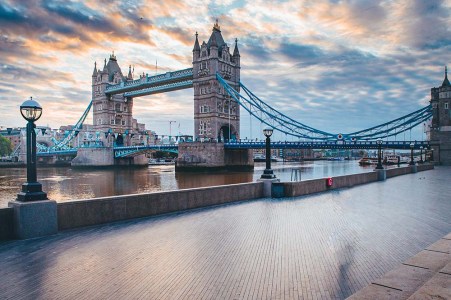
Despite everything, the Bamboovement wouldn’t be bambooving if we didn’t try to send you a positive message. There are things we have always taken for granted that weren’t positive at all. As a result of exploded tourism, Venice’s canals were so contaminated over time that when they cleared up in recent weeks, even locals were surprised to see fish living in them. Very poor air quality around the world seemed to be the norm. But the air quality has improved impressively as a result of the quarantine measures, in China, Italy, and Spain. And wildlife takes to the streets in big cities, making the beauty of our natural world visible to estranged city dwellers. These are little lights in an uncertain world, that can guide us to a better future and which the Bamboovement is more the willing to follow.
It’s heart-breaking to see that, only the hard way, we seem to understand the impact we have on our environment. So, once again, please take care of yourself, your loved ones, and also our environment. Because only together we can make our world a better place.

Elke dag voelen mensen zich schuldig over de hoeveelheid plastic die ze gebruiken. Een schuldgevoel dat wordt gevoed door plastic tandenborstels. Door plastic tasjes. En door plastic flesjes. Maar er is een simpele en betrouwbare remedie voor dit gevoel.

Het eerste dat veel mensen ’s ochtends aanraken, is een plastic tandenborstel. Het is een doodnormaal onderdeel van ons leven. Maar tegelijkertijd ook ontzettend schadelijk voor het milieu. We zijn opgegroeid met plastic tandenborstels en tandpasta. Verandering is moeilijk en het kan mogelijk een poos duren voordat je eenmaal aan die verandering gewend bent. Zoals eraan denken om een herbruikbare tas mee te nemen naar de supermarkt. Of overstappen op een bamboe tandenborstel met plasticvrije tandpasta tabletten.

Uiteindelijk stapelt je schuldgevoel zich op. Net zoals een stapel plastic zakken als gevolg van snelle supermarktbezoeken. Je weet dat er meer is wat je kunt doen. Al helemaal wanneer je onbedoeld stilstaat bij je plastic voetafdruk na het zien van de collectie plastic in je prullenbak.
Als je weer een plastic tandenborstel in de prullenbak gooit, weet je inmiddels wel waar ie terecht gaat komen. Op een stortplaats die niet bedoeld is voor recycling. Zoals veel van al het andere plastic afval dat we samen hebben opgebouwd.
Voor welke kleine verandering zou je kunnen gaan? Wat denk je van je plastic tandenborstel inwisselen voor eentje van bamboe? Vol gaan voor één duurzame stap per week of per maand (of nog beter, per dag) heeft een aanzienlijke invloed. Dit kan gaan om grote veranderingen, zoals minder vliegen of vaker de fiets in plaats van de auto pakken. Maar ook kleine aanpassingen in je leven maken echt een groot verschil. Het gebruiken van een bamboe tandenborstel is een eenvoudige manier om je plasticverbruik te verminderen.

Die dagelijkse herinnering in je badkamer stelt meer voor dan slechts een tandenborstel. In plaats daarvan is het namelijk ook een goede reminder. Eentje die je er keer op keer aan herinnert dat ook jij je steentje bijdraagt en werkt aan een plasticvrije toekomst. Zo neemt het schuldgevoel weer af en zullen je ideeën over plastic beginnen te veranderen.
Maar waarom zou je onze tandenborstel nou verkiezen boven eentje van bijvoorbeeld Colgate? De tandenborstels van The Bamboovement zijn duurzaam en natuurlijk en zijn gemaakt van MOSO Bamboe, dat tot wel één meter per dag kan groeien. De tandenborstelhaartjes worden gemaakt van nylon 610. Dit is op basis van castorolie in plaats van ruwe aardolie. Een plantaardige olie met een aanzienlijk lagere ecologische voetafdruk dan ruwe aardolie. Ondanks dit positieve aspect van nylon 610 is het nog niet biologisch afbreekbaar.
Het gebruiken van een bamboe tandenborstel is een geweldige manier om zowel een afvalvrij leven te leiden als om het milieu een handje te helpen. Want voor elke bestelling die je bij ons doet, planten wij één boom. Wij doen dit door een bedrag te doneren aan de International Association of Human Values. De IAHV werkt op zijn beurt weer samen met Eden Reforestation Projects. Dit is een nonprofit organisatie die ontboste gebieden omtovert in natuurlijke landschappen. Zij doen dit met name in ontwikkelingslanden.

Laten we het eens luisteren naar de experts. Volgens de American Dental Association, de Amerikaanse tandartsenbond, gebruikt een persoon elke 3 maanden een nieuwe tandenborstel. Samen met alle ruim 740 miljoen Europeanen gebruiken we dus bijna 4 miljard tandenborstels per jaar!
Eén persoon zou dus ongeveer 300 tandenborstels in zijn of haar leven verbruiken. Stel je eens voor dat je deze hoeveelheid plastic kunt besparen en deze hoeveelheid afval kan verminderen, gewoon door over te stappen op een bamboe tandenborstel. Klinkt als een goed idee, toch?
Ontvang een bamboe tandenborstel - voor een schone wereld
Geniet van gratis verzending op orders boven €25 én van de wetenschap dat je een verschil aan het maken bent. Bezoek onze winkel, laat je verassen door ons brede tandenborstel assortiment en koop er vandaag nog een! Bij bestellingen boven de €20,- ontvang je ook nog eens een gratis tandenborstel!
Al de trotse eigenaar van een bamboe tandenborstel? Lees dan hier onze blog met 7 creatieve tips hoe je je bamboe tandenborstel hergebruikt.
Is the current cosmetic industry a blessing or should we take it as a lesson? Nowadays, cosmetics are dominated by the beauty industry. A vast sea of celebs release one beauty care line after another. It has become a multi-billion dollar industry that has lifted consumerism to a higher level. But what is actually in all these cosmetics that people are putting on their faces and in their hair? And what are the effects they have on our planet?
Before diving into the world of natural cosmetics and the reasons why we should use natural cosmetics. We take a look at how beauty products have come to play a significant role in our daily lives. If you think about makeup you might not think of ancient civilizations, however cosmetics have a rich history. Throughout our world, cosmetics have been used for various reasons like health benefits, religious ceremonies, and social status.
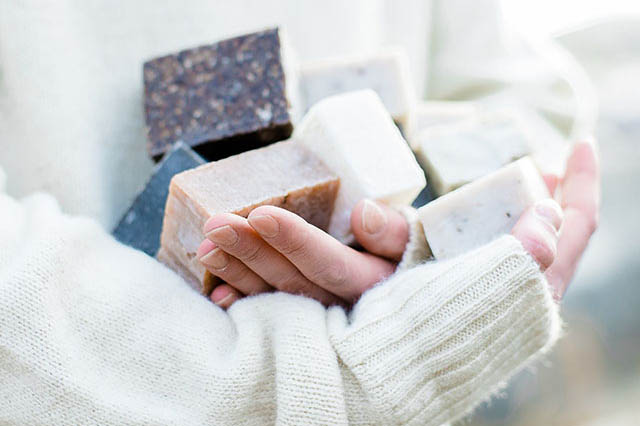
Ancient Egyptians were most likely the first civilization who started using cosmetic products. Stories go back to ancient Egyptians’ already using make-up by 10.000AC. All sorts of oils and natural creams were used, mainly to protect them against the scouring sun but for religious rituals as well.
Remarkable was that men and women would paint a combination of metal, lead, copper, ash and burnt almonds around their eyes – most likely the first version of kohl. The reason behind it was to fend off evil spirits. Interestingly enough scientists now discovered that this way of using makeup may have protected them against bacterial infections and other diseases. However, it’s hard to believe that putting lead and copper on your face is actually doing good to your skin. Heads up, natural cosmetics don’t contain copper and lead any more. Cleopatra, also known as the first devotee of red-lipstick, used lipstick that was made from crushed beetles and ants – creating strong pigmented tones.
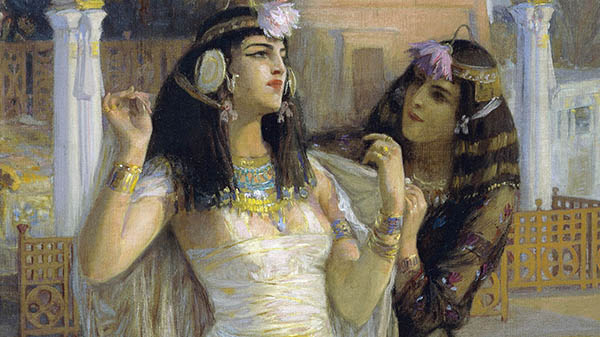
Thousands of years later, natural cosmetics were introduced into East Asian cultures. By 3000AC Chinese people would paint their fingernails with a mix of gelatin, beeswax and egg. The colours of their nails would represent a social class. The highest royals would have the luxury of painting their nails gold and silver. Members in a slightly lower class would paint them red. Lower social classes, unfortunately, had to get around with less outstanding nails and were not allowed to paint their nails with bright colours.
Of course, cosmetics were used in many more places throughout the world. Indian women, for instance, have been using henna since 300BC. In the Middle Ages, perfumes were imported on crusades from the Middle East and brought to kingdoms throughout Europe. A fun fact for our British readers – about 700 years ago when Queen Elizabeth I introduced dyed red hair as a fashion statement – society women in the British Kingdom smeared their faces with egg whites to make them paler.

So how has the role of cosmetics changed? Well, in the era of kingdoms and empires it was mainly royals wearing cosmetics. Somewhere down the line there has been a shift from kings and queens setting cosmetic trends to Hollywood celebrities. Putting some egg yolk on your face to make you look pale won’t get you too many likes on Instagram. So influencers come into play. Providing you with all sorts of tutorials on how to apply the makeup like your favourite celebrity.
One after the other star is introducing a new beauty line. To be honest with you, I have never really been spending too much time researching the amount of beauty lines celebrities have provided us with. But, there’s probably more than you can imagine. The newest to join celebs entering the cosmetic industry is Hilary Duff with a collaboration with Nudestix. According to Magazine 34th Street it’s ‘what dreams are made of’. Personally, I rather dream of beautiful white sandy beaches but I’m sure there’s a big market out there for Hilary.

It’s not without a reason that one celebrity after the other jumps into the pool of the beauty industry. Kylie Jenner became the youngest billionaire with her beauty line Kylie Cosmetics. While writing this blog, my friend told me there was some sort of scandal and that Kylie might have only been a self-proclaimed billionaire. Honestly, who really cares? I feel like I’m getting sucked too much into the world of celebs and their beauty lines.
Times have changed, from people burning some almonds, adding lead and copper to it and smearing it on your face to scrolling through thousands of influencers giving tutorials on the newest skincare products. It has, in fact, become a multi-billion dollar industry that had an estimated worth of $532 billion dollars in 2019.
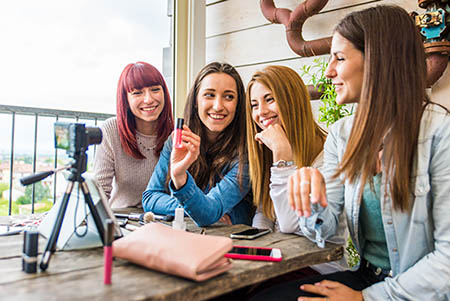
So why are a lot of beauty lines actually harmful? Let’s take a look at one of the products of our self-proclaimed billionaire – Kylie Cosmetics. I’ve dug a little deeper into the ingredients of one of her bestsellers – the Skin Concealer. The thing about ingredients in cosmetic products is that they can be as confusing as reading about quantum mechanics. So most often people have no idea what they are actually putting on their face. To apply a good rule of thumb: when your favourite celebrity uses it, it must be good! Maybe not really.. let me show you why.
So what’s in Kylie’s Skin Concealer? Well of course we’ve got Dimethicone Crosspolymer, Polymethylsilsesquioxane, Copolymer and Isopropyl Titanium Triisostearate. It already took me a while to pronounce the names of these ingredients so it comes to no surprise that most of us have no idea at all what they actually are. All these ingredients are synthetics that contain microplastics. They don’t necessarily have to be directly harmful to your skin, however they are most definitely toxic to our planet as they can’t be broken down. Also, when they are put in lip gloss and lipstick there’s a big chance that you will ingest parts of it which is actually harmful. The icing on the cake in Kylie’s Skin Concealer is probably phenoxyethanol.

Phenoxyethanol is a preservative and a synthetic ingredient that is often found in cosmetic products about 24% of all beauty products contain Phenoxyethanol. It can be very harmful and is likely to cause skin and lung irritation, especially with higher doses. Doses of less than 1% are generally excepted. However, the European Commission on cosmetic ingredients and the FDA have emphasized that phenoxyethanol is toxic, especially when applied to lips or around the mouth.
In case you are interested to discover what ingredients your favorite brand is using, you can check out the product finder of Beat the Microbeads.
Luckily there are a lot of small companies who make amazing natural products. They are not just better for your skin and hair but also a blessing for the planet. Luckily, we are also seeing some changes in the multi-billion dollar world of beauty products.
Actress Jessica Alba puts emphasize on natural cosmetics with her brand the Honest Company. The ingredients that are used in her products are free of pollutants and microplastics. Australian supermodel Miranda Kerr founded Kora Cosmetics back in 2009. There is a strong focus within the company on using natural products that don’t contain microplastics and other synthetic preservatives.

Are the Honest Company and Kora Cosmetics my best option then for natural beauty products? Not completely, but it’s a hopeful sign that there are major brands putting emphasize on natural ingredients. Hopefully they’ll be able to convince the Kylie Jenner’s of this world soon enough.
The reason why both Jessica Alba and Miranda Kerr can still improve their beauty lines is that they still rely too much on plastic, as does 99% of the cosmetic industry. Luckily there is a small group of cosmetic pioneers who are making ground the past years. Lush is probably the most famous of them all. They are a UK-based cosmetic retailer, founded in 1995 by Mark Constantine. He realized that shampoo consisted mostly of water. By taking water out of the recipe it was possible to make a shampoo bar and get rid of the plastic bottle.
If you truly want to reduce your plastic footprint, I would advise you to switch to solid cosmetics. Give your hair a break from the decades of chemicals they have endured and save our sea friends from these nasty microplastics. We still receive a lot of questions about solid cosmetics and especially about shampoo bars so here are a few things you should know about them.

Shampoo bars are a natural alternative to liquid shampoo. By taking out the water from the recipe the process becomes similar as making soap bars. The bars are made of natural plant oils, essential oils and butters. Giving your hair and scalp the nourishment it needs without all the chemicals.
Your hair might have to get used to shampoo bars the first few washes. See it as a detoxing process. Your hair might have gotten addictive to all these nasty chemicals. Usually it takes between 2 – 8 washes before your hair has gone through rehab or in the shampoo bar community also known as ‘the purge’ or ‘the waxies’. This can be the result of your scalp balancing out the oil production. The good thing about getting the waxies? It only lasts for a really short period of time and is the path to the healthiest hair you have ever had! If you don’t feel like doing a purge you can speed up the process by a vinegar rinse or by using a solid conditioner bar.
How to Reduce Plastic Use
The past years there have been amazing developments in the cosmetic industry. An easy way to reduce plastic is by making a list of plastic items you use on a daily or weekly basis. We are listing a few with some perfect alternatives.
Commercial make-up in short can be described as (not to be too blunt here) crap for the environment. The trend zero waste cosmetics is gaining a lot of popularity in recent years. And not without a reason. Higher quality products that don’t cause any harm. If you have no idea where to start looking for them, here are a few tips.
Dirty Hippie Cosmetics is an Australian plastic-free cosmetic brand. They have a wide range of plastic-free and zero waste cosmetics. If you’re not based in Australia you might want to think about the carbon offset for shipping. In case you are based in Europe I would check out Vyana Zero Waste Beauty. Vyana was founded by Daisy who set out to change the cosmetic industry with 100% natural beauty products. Her products are fair-priced, 100% cruelty-free and vegan. Another great option is FatandtheMoon. They have a large selection of hand-made cosmetic products. Their recipes are inspired by natural healers and herbalists. Besides making natural cosmetics they also actively support a number of charities.
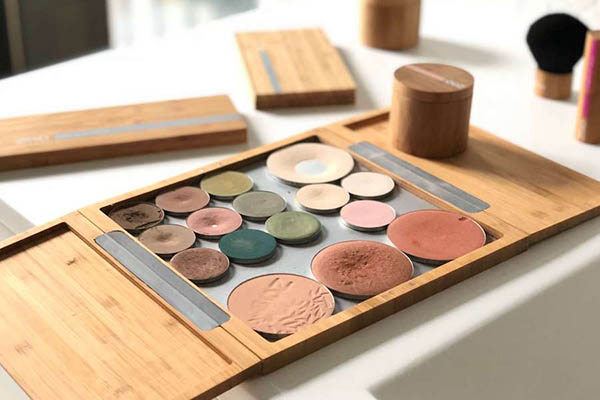
Another great benefit about natural cosmetics is that they often last much longer than their not so natural alternatives. Body bars, conditioner bars and shampoo bars equal about 3 bottles. Count the waste you are saving with one bar! The trend for cosmetic bars is exploding the last few years. Companies that are producing them are popping up everywhere. My advice would be to try out a few. It’s the same as with regular shampoo. You might like one brand better than the other.
So what should you look into when buying a bar? Personally, I like bars that foam. Maybe it’s simple, because it’s not really the foam that is rinsing your hair. But still, taking out the foam is somehow reducing my shower experience. If you have an answer for this, I’d love to hear about it in the comments. So what makes shampoo foam? Most often it’s SLS. In itself SLS isn’t harmful. However, it’s mainly made of palm oil. Look for sodium lauryl sulfate on the list of ingredients to see if your shampoo bar contains SLS. Lush has made a statement that they are currently actively working on finding a suitable alternative for SLS. Another great brand is Flow Cosmetics from Finland. Their bars are 100% natural, they are eco-certified and don’t contain SLS.
In our own shop you can find shampoo bars and body soap bars from the Dutch brand HappySoaps. We chose this brand because their bars are completely palm oil free, contain no microplastics whatsoever, are vegan and have of course only been tested on humans.
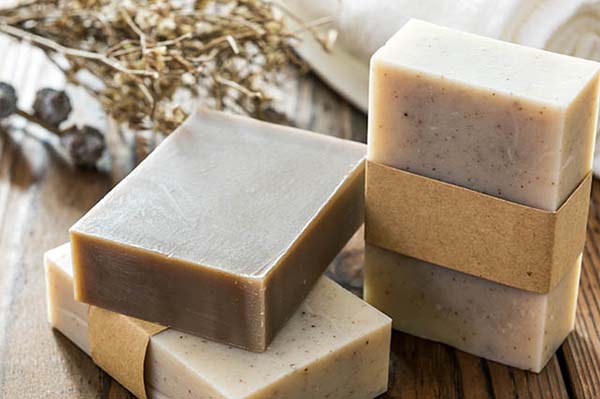
Another newcomer to the natural cosmetic industry is natural deodorant. Have you ever wondered what you are putting on your armpits? Most likely at least some aluminium and a number of parabens (which can kill corals). Switching to natural deodorant therefore isn’t only better for your own body but also for the environment. There are a few different options when you decide to ditch Dove, Nivea or Axe. Here at The Bamboovement we tried deodorant powder. Which is natural as hell, but we had a hard time getting used to it. If you would like to try it out I would go for The Ohm Collection.
We tested some natural rolls. Be careful to look at the ingredients. Many brand themselves as all natural but still contain synthetic preservatives or microplastics. In the end we liked the smearable deodorant the most. It takes a few uses to get used to it but once you’ve changed your mindset you will love the natural touch of it. We offer a couple different types now in our own webshop. They are 100% natural, vegan and last 2 – 3 months.
Are you a true eco warrior and do you have some spare time? Here is a cool blog post on how to make natural deodorant yourself.

For pretty much any cosmetic item we can find amazing plastic-free and organic alternatives. This doesn’t apply for razors though (yet). Pretty much the only option is safety razors. Peace with the Wild offers a variety of sustainable safety razors. Although, they last long and the blades can easily be replaced – they can leave some nasty cuts. Especially in some sensitive areas..
The past year we have been working here at The Bamboovement on the world’s first plastic-free razor. We received a subsidy from the Dutch government to work on this project, and we are planning to release it within the next few months. Natural shaving cream can already be found in our shop here. The razor will consist of a 100% natural bamboo handle and the cartridge is made of bamboo fibre. If you would like to stay up-to-date on the developments of our razor, you can subscribe to our newsletter.
As you can see, with a few simple daily changes you can significantly reduce your plastic consumption. If you are interested to know more about your current plastic footprint, by clicking on this link you can find a useful tool to calculate your plastic consumption.
So to get back to our question. Why should you be using natural cosmetics? We can’t really bury our head’s in the sand any more when it comes to current environmental challenges. By making some easy changes in our daily lives we can actually make a significant difference. We think it’s time to ditch the products from the Kylie Jenner’s of this world and get inspired once again by Cleopatra. However, please don’t put lead on your face.
Do you have other tips that you would like to share on how to reduce cosmetic waste? Leave a comment below! Also, in case you enjoyed reading this blog post feel free to share it with your followers to inspire more people to switch to natural cosmetics.
Ken jij manieren die wij hier niet noemen? Vertel ze ons en je medelezers in een reactie op deze blog! Het overkomt ons allemaal wel eens. Dat je ’s ochtends je tandenborstel pakt om te beginnen aan je ochtendritueel en dat je er dan achter komt dat iets niet helemaal hetzelfde is. Je kijkt naar de tandenborstel en het valt meteen op: de haartjes zijn niet meer zo robuust als dat ze ooit waren en doen je eigenlijk vooral denken aan het kapsel van iemand met een onwijze kater. Ook het handvat lijkt in niets op de mooie jonge bamboestengel die het ooit was en heeft eerder wat weg van een donker stuk drijfhout.
Je realiseert je dat deze tandenborstel je mooie glimlach voor lange tijd smetteloos heeft gediend maar dat ie ook zijn beste tijd wel heeft gehad. Hij zal plaats moet maken voor een nieuwe. Dit betekent echter niet dat je hem met een enkeltje naar de stort moet sturen. Eer je bamboe tandenborstel op een waardige manier, bijvoorbeeld door het toepassen van één van de onderstaande 7 manieren.
Als een tandenborstel niet meer geschikt voor het poetsen van tanden, kan hij toch nog op schoonmaakmissie. Door het kleine formaat, in vergelijking met bijvoorbeeld een afwasborstel, is het een heel handig hulpje voor lastig en moeilijk bereikbare plekken. Denk bijvoorbeeld aan het schoonmaken van de groeven tussen de tegels of wellicht aan het afstoffen van het toetsenbord van je computer of laptop. Al weet ik niet hoe gebruikelijk dit laatste echt is?

Van badkamer naar keuken
Een andere mogelijkheid voor een vergane bamboe tandenborstel is een verhuizing van badkamer naar keuken. In de keuken gaat ie een tweede leven aan door onmogelijk te bereiken plekken alsnog schoon te krijgen. Voorbeelden hiervan zijn de fluit van een fluitketel en de roosters van een broodrooster. Maar ook de messen van een staafmixer krijg je weer netjes schoongepoetst. Als een tandenborstel niet meer geschikt voor het poetsen van tanden, kan hij toch nog op schoonmaakmissie. Door het kleine formaat, in vergelijking met bijvoorbeeld een afwasborstel, is het een heel handig hulpje voor lastig en moeilijk bereikbare plekken. Denk bijvoorbeeld aan het schoonmaken van de groeven tussen de tegels of wellicht aan het afstoffen van het toetsenbord van je computer of laptop. Al weet ik niet hoe gebruikelijk dit laatste echt is?

Wie wil zijn of haar favoriete schoenen nou niet nog een jaartje langer kunnen dragen? Bovendien, in het kader van duurzaamheid is het belangrijk om goed voor je schoenen te zorgen en ze zo lang mogelijk mee te laten gaan. Een oude tandenborstel komt hierbij goed van pas! Koop hiervoor dus geen poetsborstel maar hergebruik je tandenborstel.

Heb je een tuin met plantjes of kweek je groenten en kruiden op de vensterbank binnenshuis? Welke plant was ook alweer welke? Hoe kom ik er achter wat waar groeit zonder op de bloemetjes en groenten te moeten wachten? Mogelijk herken je deze twijfels. Het kan natuurlijk de besten overkomen. Een oude bamboe tandenborstel biedt ook de besten een oplossing. Na het verwijderen van de haartjes, met bijvoorbeeld een tangetje, blijft er een 100% natuurlijk bamboestengeltje over waar je perfect de naam van een plantje op kan schrijven. LET OP! Deze recycling-methode is voornamelijk geschikt voor die-hard bamboe tandenborstelgebruikers. Elke keer dat je je realiseert dat het tijd is voor een nieuwe tandenborstel levert de oude namelijk maar één naambordje op…
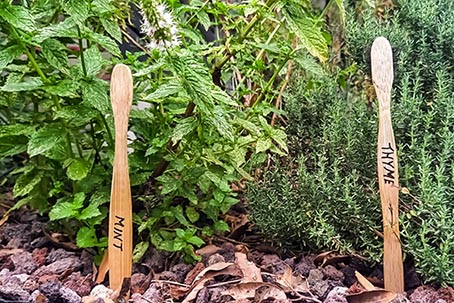
Plantenstok
Deze manier van hergebruiken spreekt redelijk voor zich maar houd er wel rekening mee dat je geen bonenstaak aan je kleine tandenborsteltje vast laat klampen. Haal de haartjes van de tandenborstel af en bind je hangende plantje losjes vast met een plasticvrij touwtje. De plantenstok is er helemaal klaar voor. LET OP! Vooral geschikt voor beginnende tuinders die aan de slag gaan met hun eerste plantje. Voor mensen die meerdere planten vast willen binden is deze methode weer met name geschikt voor de die-hard bamboe tandenborstelgebruikers.

Wierook houder
Ook voor deze optie moet je de haartjes eruit halen, waardoor de kleine openingen in het uiteinde van de tandenborstel zichtbaar worden. Hier passen stokjes wierook precies in. Alsof het ervoor gemaakt is. TIP: laat je fantasie de vrije loop en maak er iets unieks van! Met wat creativiteit en acrylverf maak je het bamboe handvat al gauw compleet onherkenbaar.
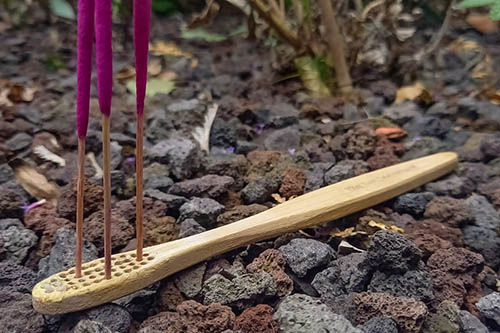
Wakker je fantasie aan en blaas je artistieke skills nieuw leven in. Een bamboe handvat heeft een onbeperkt potentieel als je je creatieve geest zijn gang laat gaan. Door er wat spijkertjes in te slaan en hem in de breedte op te hangen aan de muur maak je er een unieke sleutelbos-houder van. Knoop er een touwtje omheen en je hebt prachtig speelgoed waar je je poes of kat eindeloos mee kunt vermaken. En zo zijn de mogelijkheden letterlijk eindeloos, verras jezelf!
Kort gezegd: upcycling is een van de pijlers van een duurzaam leven. Een kleine stap kan een enorme impact hebben. Een kleine stap als het hergebruiken van je oude bamboe tandenborstel stimuleert de motivatie tot upcycling. Daarnaast vermindert het de neiging om overal iets nieuws, en vaak onnodigs, voor aan te schaffen. Het enige wat je hoeft te doen is deze mentaliteit vasthouden en creatief te zijn om oude dingen een nieuw leven te geven! Benieuwd hoe duurzaam je bamboe tandenborstel echt is? Lees hier onze blog waarom bamboe tandenborstels écht duurzamer zijn.
Weet jij meer manieren om een bamboe tandenborstel te hergebruiken? Deel ze met ons in een reactie hieronder en inspireer zo ons én anderen. Wil je nog meer mensen inspireren om bamboe tandenborstels te hergebruiken? Deel deze blog dan met je volgers!
